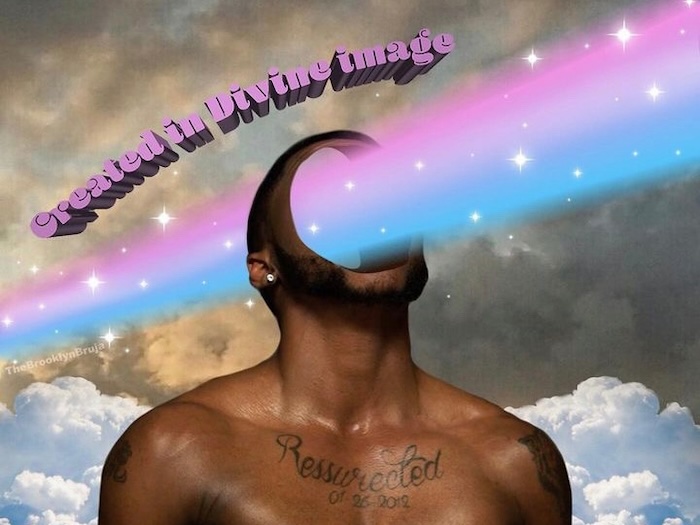— For contemporary artists like Río Edén, Mx. Zeloszelos Marchandt, and Elliot Barnhill, making religious art is a revolutionary act

By Emma Cieslik
Surrounded by tulips and lilacs, a Black person with top surgery scars and a chest tattoo reading “Resurrected 01-26-2012” raises their face up to the sky. Titled “Created in Divine image” (2020), a phrase repeated in pink text against a background of gray clouds, that person’s hollow face is pierced by rays of pink, white, and blue light — the colors of the trans pride flag. In the Instagram caption accompanying his work, trans artist Río Edén wrote, “Blessed be those who live outside the binary, bless be those who challenge the binary, bless be those who are trans.”
Edén, also known as The Brooklyn Bruja, is part of a growing artistic movement visualizing the divinity of queer bodies and the queerness of religious figures. This movement gained steam in the last three years, right as scholars are rediscovering how Jesus and the saints may have been queer according to personal writings and hagiographies and have been depicted as queer for centuries by LGBTQ+ artists and others grappling with how divinity supersedes gender binaries. I myself have written about genderqueer-ness in Medieval theologians’ interpretations of Christ. At the same time, artists like Edén are depicting saints and religious figures as visually queer through the inclusion of top surgery scars, breast augmentation, body hair, and other attributes, while also celebrating the divinity and queer sainthood of LGBTQ+ folx today.
Edén is a trans autistic person of color, with Borderline Personality Disorder (BPD), Complex Post-traumatic Stress Disorder (C-PTSD), Attention-Deficit/Hyperactivity Disorder (ADHD), and anxiety. He grew up in a Baptist family that later converted to Pentecostalism — an extremely homophobic religious sect. He was outed by his mom at 15 and entered conversion therapy at 17. He was thus forced back into the closet, only officially coming out at 21. He began to medically transition almost three years ago, first starting hormone replacement therapy in June 2021.

“Created in Divine image” is made in Edén’s typical style of ethereal collages overlapping faceless figures, natural backgrounds, halos, and shimmering color gradients. Its religious imagery is strikingly similar to another collage featuring Daniel Davis Aston. In that work, Edén memorializes Aston, who was killed in the Club Q shooting in Colorado Springs in November of 2022, as a queer saint martyred in the fight for trans existence.
For those who know Edén’s backstory, it may seem anathema for him to reclaim the religious words and symbols that made him feel shame. But Edén disagrees. He views his art as a form of divine protest. “I was taught that man and woman were created in the image of God,” he explained to Hyperallergic, “but then when they talk about trans and queer people, that message starts to fade off, and I don’t like to have queer people feel the way that I did where they feel excluded from having that divineness too.” For Edén, creating religious art is in of itself a revolutionary act: The White, straight, Christians who surrounded him growing up have controlled what Jesus and God look like for too long.
If they can depict Jesus as a cishet, monogamous White man, Edén argued, then he too can show that Jesus was made in his own image, as a trans person of color.

Edén’s practice is not just about dismantling heteronormativity in religious art, but also about depicting LGBTQ+ individuals of color as divine, in a similar vein to trans performance and visual artist Mx. Zeloszelos Marchandt. In “Ecce Homo” (2023), for instance, Marchandt depicts himself as a Black, Indigenous, and trans Jesus. Both Edén and Marchandt encounter Him through their own bodies, and thus visualize Jesus — mouthpiece for God on Earth — as a spokesperson for communities facing oppression today.
As Edén argues, no one really knows how Jesus presented or identified. The same is true of many saints, but in Alicia Spencer-Hall and Blake Gutt’s 2021 book Trans and Genderqueer Subjects in Medieval Hagiography, Medieval scholars argue that illuminators visualized Jesus and God as transcending the human concept of gender. Many saints were queer and because of their proximity to God were depicted as visually queer by Medieval artists.

Queer depictions of saints date back centuries, and queer creators today are reclaiming and reviving this artistic tradition. Elliott Barnhill, a disabled transmasc queer Catholic and seminary graduate, reimagines saints who have canonically been depicted as straight, hyperfeminine, or hypermasculine. His own coming out was predicated upon “becoming aware that the things we now call queerness can be found in the lives of saints,” he told me. His mission to spread that awareness extends beyond visual depictions: He founded the Instagram account Queer Catholic Icons and the podcast Blessed are the Binary Breakers.
With seraphs bearing top surgery scars, Barnhill creates distinctly modern queer Catholic icons in bold defiance of the Church’s queerphobic stance. Similarly, queer femme artist Dani explores butchfemme identity in her portraits of Catholic saints through her Instagram account AndHerSaints. With intimate portraits of St. Therese of Lisieux and St. Joan of Arc, their works center on dignity: acknowledging that queer lives and experiences are sacred and holy.
All of these artists, along with others like text-based artist Girl of Sword and whole zines dedicated to trans+ Christian art such as The Transient Theology Project, are part of a queer artistic Renaissance that affirms the dignity and divinity of queer people centuries ago and today. In doing so, they not only challenge the dichotomy of queerness and religion, but disrupt queerphobic religious teachings that seek to harm queer folx. As these artists and scholars argue, their queerness just brings them that much closer to God.


Complete Article ↪HERE↩!
